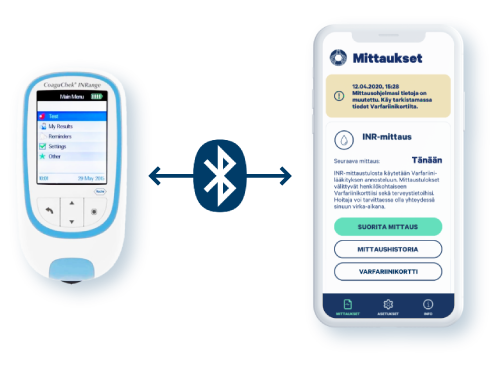
The modern treatment pathway for INR patients – with a Pay for Performance – pricing!
A modern way of treating your warfarin patients
1Time in Therapeutic Range
Traditional warfarin controls, managed by central laboratories, are resource-intensive and require time and resources from both the healthcare providers and the patients. In addition, the treatment results it brings usually leaves room for improvement.
Orla INR Remote Monitoring enables better treatment results and improves the patients’ perceived quality of life. The healthcare professional has an immediate, 24/7 insight into the treatment, creating peace of mind for both healthcare professionals, as well as patients.
Orla INR Remote Monitoring comes with a Pay for Performance (PfP) pricing; if the treatment is not deemed successful, the service does not need to be paid for.
Anticoagulation therapy is efficient when implemented well
Compliance affects the effectiveness of treatment with both warfarin and DOAC1
Warfarin treatment
The VKA value2 should remain within the treatment range more than 65% of the time3
DOAC treatment
The adherence should be >80%4
1Direct Oral Anticoagulant. 2Vitamin K antagonist. 3https://pubmed.ncbi.nlm.nih.gov/28317274/ 4https://doi.org/10.1161/CIRCOUTCOMES.119.005969
In both warfarin and DOAC-treatments, compliance is one of the most important factors affecting the efficiency of the anticoagulation therapy.
Several studies of warfarin treatment have demonstrated that in order to achieve good outcomes, the patient’s INR-value should remain within the treatment range more than 70% of the time (TTR>70). The best outcomes are achieved when the patient remains within the treatment range more than 80% of the time (TTR>80).
These objectives are currently achieved with variable degree. Comparative studies of DOACs vs. warfarin demonstrate that the TTR-values of the control groups using warfarin has been on average between 55 and 67.
Adherence is important also in DOAC-treatment, and it should stay above 80% for anticoagulation to be efficient enough. In follow-up studies it has however been observed that as much as a third of patients do not reach this adherence, which leads to an increased risk of a unwanted events.
1DUODECIM 2012;128(2):139-46 2FinWAF; https://pubmed.ncbi.nlm.nih.gov/28317274
The worst option for anticoagulation patients, for the healthcare, as well as for the society is obviously treatment with suboptimal adherence and outcomes.
The Finnish FinWAF-study showed that the risk for patients with poorly balanced anticoagulation to experience a terminal event (stroke) or dying, was three times higher than for patients with a good warfarin treatment (TTR>70). If compared to warfarin treatment with very good results (TTR>80), the difference is even more significant.
Poorly controlled anticoagulation exposes patients to unwanted endpoints as well as causes extensive costs for healthcare and society, due to the fact that poor anticoagulation therapy comes with a cost, added by the cost of terminal events.
Better treatment outcomes with Orla Remote Monitoring
Most in VKA therapy achieved a good care balance1
The distribution of TTR before using Orla INR
The mean TTR pre intervention in the cohort was 70.71 (SD +/- 18.7); median 71.13 [IQR 56.7 – 84.8]
Half of the patients achieved outstanding treatment results (TTR >80%) and most achieved a good treatment balance
Mean TTR post intervention in the cohort was 75.72 (SD +/- 20.2); median 79.4 [IQR 64.2 – 88.6]
1 Orla Data on file
Orla INR Remote Monitoring is already in use at several healthcare centers around Finland and we have gathered Real World Data of the outcomes. The results show that Orla INR Remote Monitoring improves the treatment outcomes, moving half of the patients to the “very good” treatment outcome and the majority of the rest to the “good outcome” groups.
By choosing Orla Remote Monitoring, you are choosing a modern way to treat your patients and save resources. At the same time, you are decreasing the risk of expensive terminal events that materialize as cost of hospital as well as home care.
Pay only for efficient treatment and ensure successful treatment
1 Assure the best protection for the patient
- Automatic insight into treatment compliance and results
2 Care as cost-effectively as possible
- With Orla’s effectiveness guarantee you only pay when treatment is efficient
- Orla invoices only according to the patients whose warfarin treatment balance is good or very good
Orla INR Remote Monitoring is the only anticoagulation treatment that offers a guarantee of effectiveness in the form of a Pay for Performance-pricing concept. All patients that do not reach good (TTR>70) or excellent (TTR>80) treatment outcomes during the first four months, receive the service for free.
The guarantee of effectiveness gives the healthcare professionals the opportunity to assess which patients receive the most effective care with Orla Remote Monitoring, and for whom another treatment method would be more suitable.
Orla INR care model
- Patient measures the INR value and adjusts the warfarin dosage1
- Patient use the Orla Remote Monitoring mobile app, Roche Diagnostics CoaguChek® INRange measurement device and 24 test strips a year
- Electronic warfarin card
- Reminders of the following measurement time
- Information that the healthcare professional sees the level of care

1 There is a possibility for self-measurement while using Orla Remote Monitoring, in which case the healthcare professional adjusts the warfarin dosage for the patient
Orla INR Remote Monitoring gives healt care professionals the option to assign suitable patients to INR self-care or INR self-measurement. When using Orla Remote Monitoring, the patient measures the INR value her-/himself. The patient can then adjust the warfarin dosage her-/himself (self-care) or the warfarin dosage is adjusted by the healthcare professional (self-measurement).
Orla Remote Monitoring gives a 24/7-insight into the anticoagulation treatment of the patient.
The process itself is similar to the process of the normal INR self-care or INR self-measurement. By digitalizing the treatment pathway, patients however remain under continuous supervision of the healthcare professional.
The change process begins with the selection of patients, although it can be stated that there are very few patients for whom the service would not be suitable. After receiving training, the patient has in use the Orla Remote Monitoring mobile app, Roche Diagnostics CoaguChek® INRange measurement device as well as 24 test strips a year.
The patient also has an electronic warfarin card with information about the medication, and the mobile app reminds the patient when it is time for the next measurement. The patient can take the measurements and adjust the dosage with confidence, as the patient knows that a healthcare professional remotely supervises the actions.
Transition to modern warfarin treatment monitoring
Orla has together with the healthcare centers using the INR remote measurement service created an implementation process, which allows the transition to modern warfarin treatment monitoring to go easily and in a coordinated way.
The goal of the project is to assign as many warfarin patients as possible to good care, and to assign patients not suited for warfarin treatment to a treatment method better suited for them.
We want to help healthcare facilities take advantage of digitalization wherever it has shown to be beneficial. In this case, digitalization also enables better monitoring of treatment outcomes and decision-making based on data.
As a result of the project we can improve the implementation of anticoagulation therapy and reduce the unwanted terminal events, and hence improve the cost-effectivity of the care.
